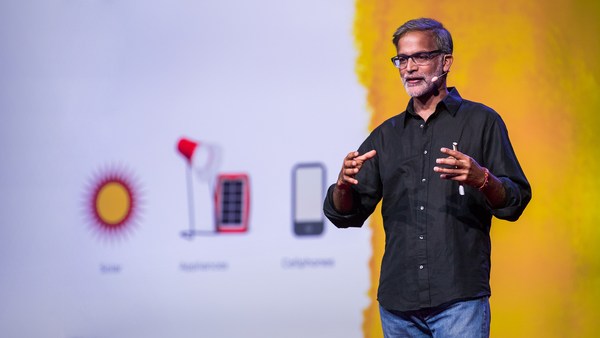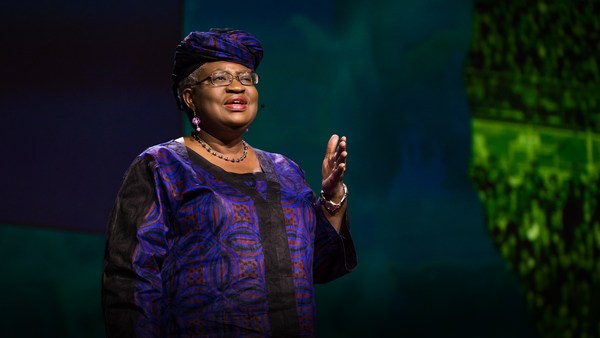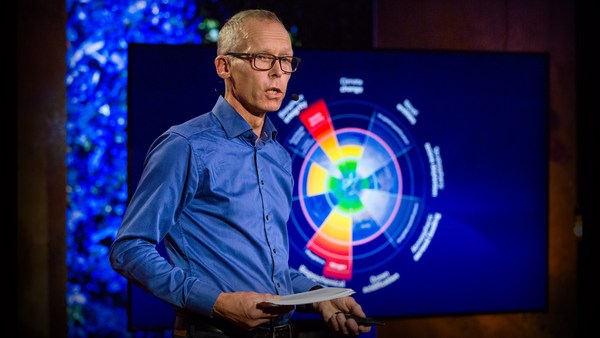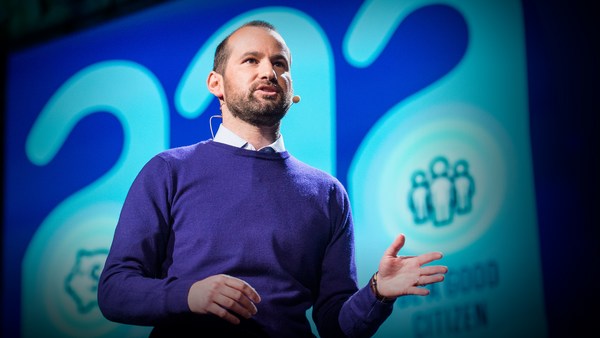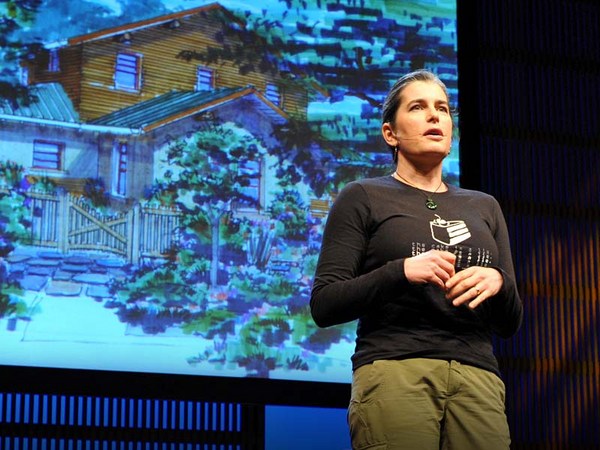So right now, nearly one billion people globally don't have access to electricity in their homes. And in sub-Saharan Africa, more than half of the population remain in the dark.
So you probably all know this image from NASA. There's a name for this darkness. It's called "energy poverty," and it has massive implications for economic development and social well-being. One unique aspect of the energy poverty problem in sub-Saharan Africa -- and by the way, in this talk when I "energy," I mean "electricity" -- one thing that's unique about it is there isn't much legacy infrastructure already in place in many countries of the region. So, for example, according to 2015 data, the total installed electricity capacity in sub-Saharan Africa is only about 100 gigawatts. That's similar to that of the UK.
So this actually presents a unique opportunity to build an energy system in the 21st century almost from scratch. The question is: How do you do that? We could look back to the past and replicate the ways in which we've managed to bring stable, affordable electricity to a big part of the world's population. But we all know that that has some well-known terrible side effects, such as pollution and climate change, in addition to being costly and inefficient. With Africa's population set to quadruple by the end of the century, this is not a theoretical question. Africa needs a lot of energy, and it needs it fast, because its population is booming and its economy needs to develop.
So for most countries, the general trajectory of electrification has been as follows. First, large-scale grid infrastructure is put in place, usually with significant public investment. That infrastructure then powers productive centers, such as factories, agricultural mechanization, commercial enterprises and the like. And this then stimulates economic growth, creating jobs, raising incomes and producing a virtuous cycle that helps more people afford more appliances, which then creates residential demand for electricity.
But in sub-Saharan Africa, despite decades of energy projects, we haven't really seen these benefits. The energy projects have often been characterized by waste, corruption and inefficiency; our rural electrification rates are really low, and our urban rates could be better; the reliability of our electricity is terrible; and we have some of the highest electricity prices in the whole world. And on top of all of this, we are now facing the impacts of the growing climate catastrophe head-on. So Africa will need to find a different path.
And, as it turns out, we are now witnessing some pretty exciting disruption in the African energy space. This new path is called off-grid solar, and it's enabled by cheap solar panels, advances in LED and battery technology, and combined with innovative business models. So these off-grid solar products typically range from a single light to home system kits that can charge phones, power a television or run a fan.
I want to be clear: off-grid solar is a big deal in Africa. I have worked in the sector for years, and these products are enabling us to extend basic energy services to some of the world's poorest, raising their quality of life. This is a very good and a very important thing. However, off-grid solar will not solve energy poverty in Africa, and for that matter, neither will a top-down effort to connect every unserved household to the grid. See, I'm not here to rehash that played-out "on-versus-off-grid" or "old-versus-new" debate. Instead, I believe that our inability to grapple with and truly address energy poverty in Africa stems from three main sources.
First, we don't really have a clear understanding of what energy poverty is, or how deep it goes.
Second, we are avoiding complex systemic issues and prefer quick fixes.
And third, we are misdirecting concerns about climate change. Combined, these three mistakes are leading us to impose a Western debate on the future of energy and falling back on paternalistic attitudes towards Africa.
So let me try and unpack these three questions. First, what exactly is energy poverty? The main energy poverty targeted indicator is enshrined in the UN's Seventh Sustainable Development Goal, or SDG 7. It calls for 100 percent of the world's population to have access to electricity by the year 2030. This binary threshold, however, ignores the quality, reliability or utility of the power, though indicators are currently being developed that will try and capture these things.
However, the question of when a household is considered "connected" is not quite clear-cut. So, for example, last year the Indian Prime Minister Narendra Modi declared all of the villages in India electrified, the criteria for electrification being a transformer in every village plus its public centers and 10 percent -- 10 percent -- of its households connected. Meanwhile, the International Energy Agency, which tracks progress against SDG 7, defines energy access as 50 kilowatt hours per person per year. That's enough to power some light bulbs and charge a phone, perhaps run a low-watt TV or fan for a few hours a day. Now, providing entry-level access is an important first step, but let's not romanticize the situation. By any standard, a few lights and not much else is still living in energy poverty. And what's more, these energy poverty indicators and targets cover only residential use. And yet, households account for just about one quarter of the world's electricity consumption. That's because most of our power is used in industries and for commerce.
Which brings me to my main point: countries cannot grow out of poverty without access to abundant, affordable and reliable electricity to power these productive centers, or what I call "Energy for Growth." As you can see from this graph, there's simply no such thing as a low-energy, high-income country. It doesn't exist. And yet, three billion people in the world currently live in countries without reliable, affordable electricity -- not just to power their homes but also their factories, their office buildings, their data centers and other economic activities. Merely electrifying households and microenterprises cannot solve this deeper energy poverty. To solve energy poverty, we need to deliver reliable, affordable electricity at scale, to power economy-wide job creation and income growth.
This need, however, bumps against an emerging narrative that, faced with climate change, we all need to transition from large, centralized power systems to small-scale distributed power. The growth of off-grid solar in Africa -- and let me repeat, off-grid solar is a good thing -- but that growth fits nicely into this narrative and has led to those claims that Africa is leapfrogging the old ways of energy and building its power system from the ground up, one solar panel at a time.
It's a nice, solicitous narrative, but also quite naïve. Like many narratives of technological disruption, often inspired by Silicon Valley, it takes for granted the existing systems that underpin all of this transformation. You see, when it comes to innovating and energy, the West is working around the edges of a system that is tried and tested. And so all the sexy stuff -- the rooftop solar, the smart household devices, the electric vehicles -- all of this is built on top of a massive and absolutely essential grid, which itself exists within a proven governance framework. Even the most advanced countries in the world don't have an example of an energy system that is all edges and no center at scale.
So ultimately, no approach -- be it centralized or distributed, renewable or fossil-based -- can succeed in solving energy poverty without finding a way to deliver reliable, affordable electricity to Africa's emerging industrial and commercial sectors. So, it's not just lights in every rural home. It's power for Africa's cities that are growing fast and increasingly full of young, capable people in desperate need of a job. This in turn will require significant interconnectivity and economies of scale, making a robust and modern grid a crucial piece of any energy poverty solution.
So, our second mistake is falling for the allure of the quick fix. You see, energy poverty exists within a complex socioeconomic and political context. And part of the appeal of new electrification models such as off-grid solar, for example, is they can often bypass the glacial pace and inefficiency of government. See, with small systems you can skip the bureaucracies and the utilities and sell directly to customers. But to confront energy poverty, you cannot ignore governments, you cannot ignore institutions, you cannot ignore the many players involved in making, moving and using electricity at scale, which is a way to say that when it comes to providing energy for growth, it's not just about innovating the technology, it's about the slow and hard work of improving governance, institutions and the broader macroenvironment.
OK, so this is all good and nice, you say. But what about climate change? How do we ensure a high-energy future for everyone while also curbing our emissions? Well, we'll have to make some complex tradeoffs, but I believe that a high-energy future for Africa is not mutually exclusive to a low-carbon future. And make no mistake: the world cannot expect Africa to remain in energy poverty because of climate change.
(Applause)
Actually, the facts show that the opposite is true. Energy will be essential for Africa to adapt to climate change and build resilience. You see, rising temperatures will mean increased demand for space cooling and cold storage. Declining water tables will mean increased pumped irrigation. And extreme weather and rising sea levels will require a significant expansion and reinforcement of our infrastructure. These are all energy-intensive activities. So balancing climate change and Africa's pressing need to transition to a high-energy future will be tough. But doing so is nonnegotiable; we will have to find a way. The first step is broadening the terms of the debate away from this either-or framing. And we also must stop romanticizing solutions that distract us from the core challenges.
And let's not also forget that Africa is endowed with vast natural resources, including significant renewable potential. For example, in Kenya, where I'm from, geothermal power accounts for half of our electricity generation, and with hydro being the other major source, we are already mainly powered by renewable energy. We also just brought online Africa's largest wind farm and East Africa's biggest solar facility.
(Applause)
In addition, new technology means that we can now run and design our power systems and use energy more efficiently than ever, doing more with less. Energy efficiency will be an important tool in the fight against climate change.
So in closing, I'd just like to say that Africa is a real place with real people, navigating complex challenges and major transitions, just like any other region of the world.
(Applause)
And while each country and each region has its social, economic and political quirks, the physics of electricity are the same everywhere.
(Laughter) (Applause)
And the energy needs of our economies are just as intensive as those of any other economy.
So, the expansion of household electrification through a mix of on- and off-grid solutions has had an incredible impact in Africa. But they are nowhere near sufficient for solving energy poverty. To solve energy poverty, we need generation of electricity from diverse sources at scale and modern grids to power a high-energy future, in which Africans can enjoy modern living standards and well-paying jobs. Africans deserve this, and with one of every four people in the world projected to be African by the year 2100, the planet needs it.
Thank you.
(Applause)
